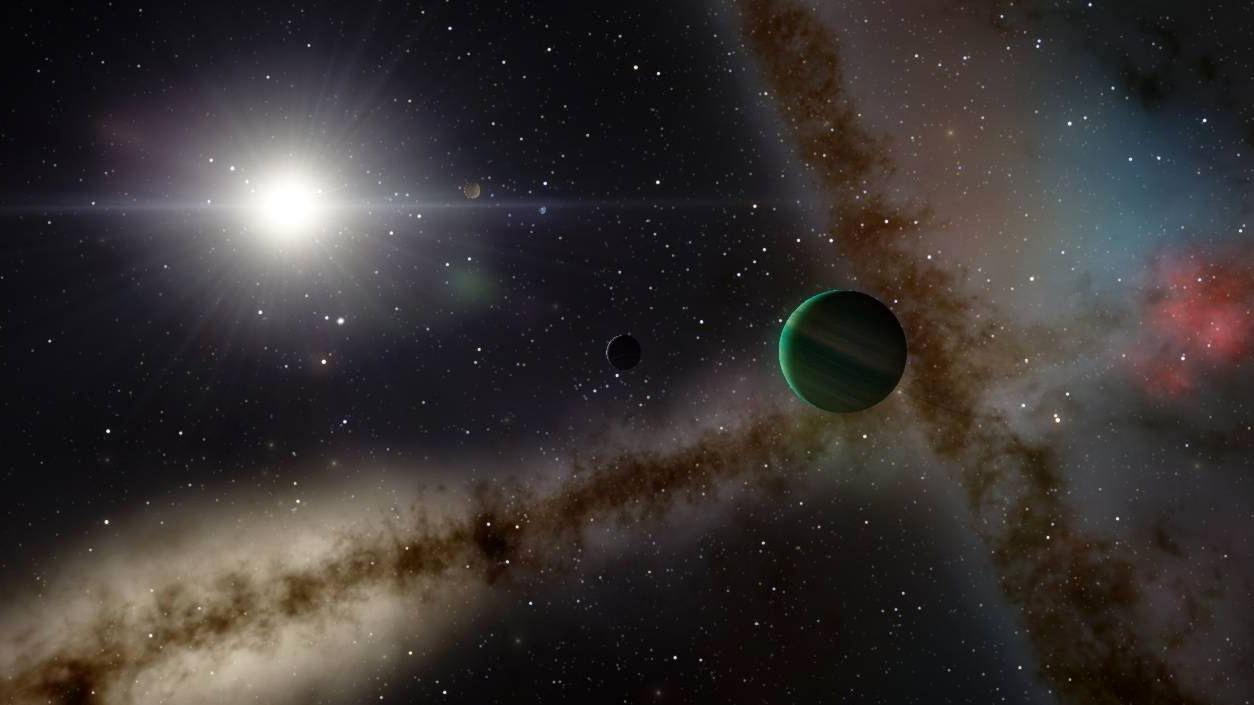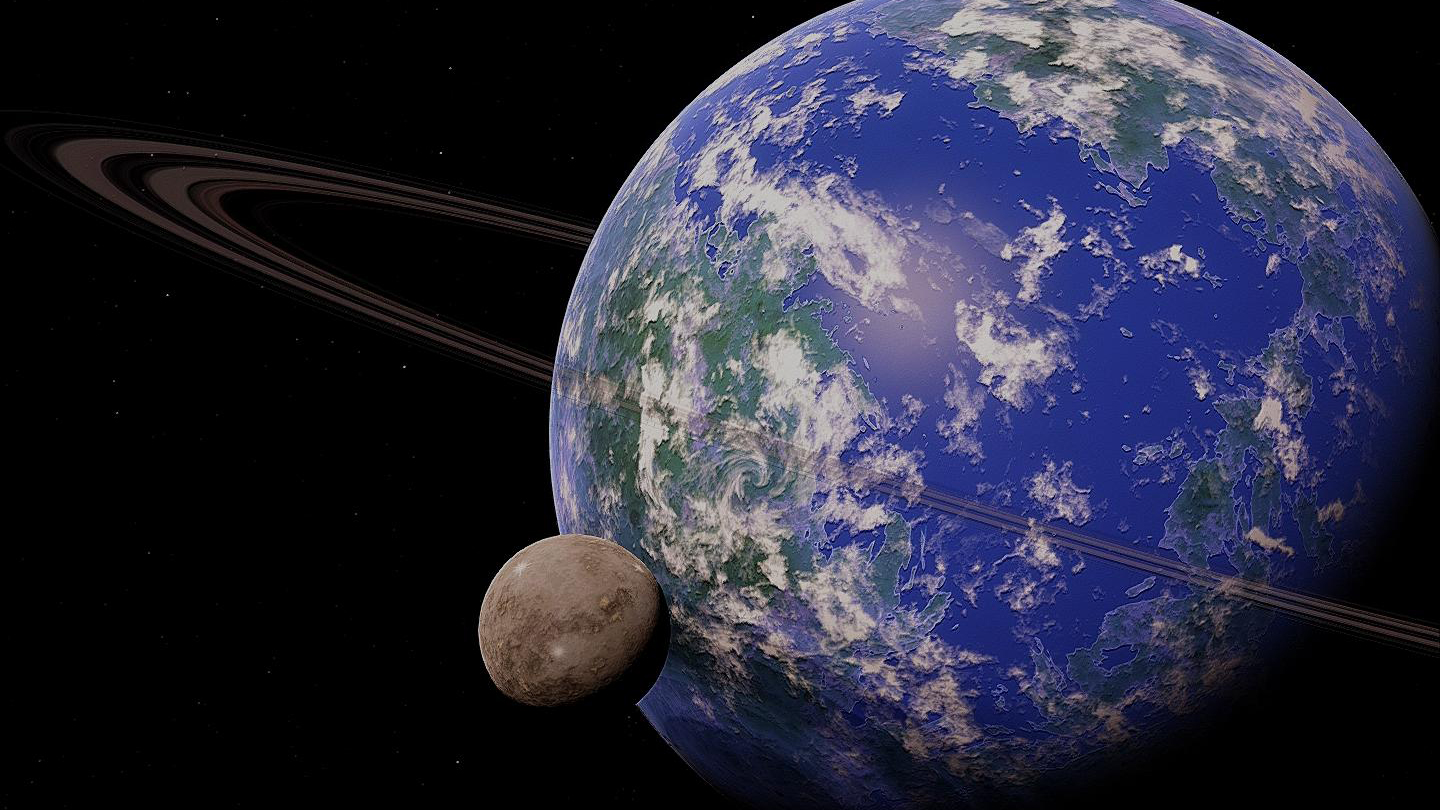There are one hundred billion galaxies in the universe, and you can visit every one.
The SpaceEngine simulator may sound like one of this year’s most anticipated games — it’s an unfathomably massive, independently developed, procedurally generated universe.
But this isn’t No Man’s Sky. You won’t find any alien outposts, cartoonish creatures, fluorescent flora, or multi-tools to mine imaginary minerals with. There’s no $60 price tag or Sony-backed marketing campaign. There’s just one guy with his computer, and a free-to-download sandbox simulator.
SpaceEngine is a universe, a tremendous tract of empty space and more explorable worlds than anyone can comprehend. The program boasts the entire Hipparcos catalog of stars, 10,000 known galaxies, and practically every recorded celestial body from asteroids to exoplanets. In total, it contains over 130,000 real space objects.
The newest algorithm generates 10 trillion galaxies and some sextillion stars. The number of planets are, quite literally, countless.
But the universe is bigger than that. Much bigger.
Russian astronomer-cum-game developer Vladimir Romanyuk knew he could never write enough code to represent the entire universe. He didn’t have time. He could, however, develop algorithms to fill in the gaps and expand his to an incredible scale.
“The idea to use procedural generation came naturally,” Romanyuk tells Digital Trends. “You can model a planet off its general parameters like mass, radius, and temperature,” he says, but the topographies of most distant bodies are impossible to replicate because we have few clues to what they really look like. The Milky Way alone has 100 billion planets with surfaces hidden from even our strongest telescopes.
The universe may be vast, populated with innumerable bodies, but there aren’t all that many types of objects. “I can even count them,” Romanyuk says, “galaxies, nebulae, star clusters, stars (including normal stars, giants, white dwarfs, neutron stars, and black holes), and planetary objects (planets, moons, asteroids and comets).” So, in 2005, he began methodically populating his simulator with sets of data from astronomical catalogs.
Romanyuk generated the basic outline of known galaxies, clusters, systems, and planets. His procedural generation algorithms gave those bodies their character.
From few, many
Procedural generation may be this season’s video game buzzword, but believe it or not, the concept isn’t new. For decades, developers have automatically created large amounts of content from relatively small sets of parameters.
Back in the late 1970s and early 1980s, role playing games used algorithms to construct maps with unique dungeons, creatures, and treasure chests in an effort to save valuable disk space. Though procedurally generated environments lacked the delicate touch of manmade design, they let developers create deeper, more immersive gaming experiences by prioritizing things like game mechanics and narratives.
But memory limits aren’t what they used to be. Today’s developers use procedural generation to offer unique experiences rather than save memory. No Man’s Sky’s, for example, crams its detailed flora and fauna of 18 quintillion planets into just 6 GB of disk space.
SpaceEngine, meanwhile, requires 960 MB.
The most recent version of the simulator launched last month in the shadow of the hype surrounding No Man’s Sky. To Romanyuk’s estimation, the newest algorithm generates 10 trillion galaxies and roughly a sextillion stars. The number of planets are, quite literally, countless.
Endless exploration
Board a spacecraft from Earth, scan the sky for Pleiades, set the ship’s bow, power its thrusters, and accelerate into hyper speed. Jupiter zooms by as your ship exit the solar system at hundreds-of-thousands of miles per hour. A moment later a black sphere forms around the bow of your ship as you jump into warp drive.
The universe is huge and the distance between objects can be deceptive, but at this speed the 440 light year trip to Pleiades takes seconds.
You travel to another distant solar system in a few minutes and select one of it’s planets, gliding into orbit. The simulation’s orbital mechanics are precise — rigid even — but easy enough for the average user to get the hang of. “I wanted to make it easy for people,” he says, “not just professional and amateur astronomers.”
As your ship descends upon the foreign world, binary stars rise from its horizon. Their rays bounce off the planet’s atmosphere, magnifying its purplish hue with a hint of green, a sign of photosynthetic life. When the ship dips beneath the clouds, you’re met by a thousand-mile canyon with liquid-filled crevasses, red clay walls, and leafy peaks.
This planet doesn’t exist — but it could.
It’s one of innumerable, detailed bodies in the SpaceEngine universe. Many of the planets are breathtakingly beautiful.
And yet, every feature found in SpaceEngine is bound by physical, scientific reality. There’s no friction in space and no sound. Planets orbit solar systems. Solar systems form galaxies that orbit black holes. “I wanted to depict actual space,” Romanyuk says. “Just real nature.”
Which isn’t to say you won’t find oddities in outer space.
Stranger than fiction
Life is surprisingly abundant in SpaceEngine and it isn’t limited to the carbon-based forms found on Earth. “I’m not a carbon chauvinist,” Romanyuk says. Sure, Earthlings are all made of strings of carbon atoms, but even Stephen Hawking thinks life could evolve from some other chemical basis.
“Non-carbon-based lifeforms probably only exist as unicellular organisms because the universe is too young for them to develop,” Romanyuk says. “Their evolution must be extremely slow, taking into account the temperature of liquid methane.” If Romanyuk were to develop the life in SpaceEngine further, he thinks these organisms would be the easiest to implement.

A bigger challenge would be procedurally generating multicellular lifeforms that are both realistic, observable, and not so complex that they lag the simulation.
In fact, Romanyuk admits procedural generation itself is probably his biggest challenge. “Making a generated universe look real, taking into account real physical laws and astronomical observations is difficult,” he says. “And, of course, keeping this all real-time, so SpaceEngine can run on a standard desktop PC or gaming laptop adds an additional challenge.”
It’s relatively easy to program the collision of two galaxies — a cataclysmic event Romanyuk hopes to someday include in SpaceEngine — but most modern computers can’t run this in real time. “So I have to choose what can be modeled naturally and what must be skipped for the sake of performance,” he says.
To be sure, a handful of users have helped Romanyuk develop planet textures, galaxy models, spacecraft, music, and translations to 20 languages. But, since the beginning, he’s had plans to commercialize the game so he kept the source code closed and remained the man in charge.
Funding the future
Romanyuk wants to include every scientifically conceivable aspect of the universe in SpaceEngine, procedurally generated or not. “This is quite ambitious of course,” he says, “so I have to set up priorities.”
And he has to get funding.
SpaceEngine has been free since its early-stage launch in 2005, when the game was too primitive to charge money for. But responses were positive and, as the simulator built a small but devoted community of users, Romanyuk realized he could speed up development by quitting his job and crowdfunding the game’s development. It’s since been downloaded hundreds-of-thousands of times and donations have topped $45,000, which allows him to develop SpaceEngine full time.
“But now it seems not enough — I need more programmers.”
“But it seems not enough,” Romanyuk admits. “I need more programmers.”
With the first milestone of donations reached, Romanyuk hopes to develop things like virtual reality and compatibility with Linux and Mac OS, since the game currently only runs on Windows. Future goals include expanded gameplay with building and research mechanics at $80,000, online exploration at $120,000, and an MMORPG at $250,000.
“I am now focused on preparing for release on Steam,” he says. “This will be a paid version but more advanced than the free one, with more frequent updates, VR, and other features.”
But users aren’t waiting around for those features — instead, they’re creating their own. And though Romanyuk has devoted himself to the project for over a decade, he’s still sometimes surprised by what fans create.
As Romanyuk sits clicking through user-uploaded images on the SpaceEngine forum, he discovers something that amazes him, and his scientific stoicism dissolves into glee.
“Oh my god!” he shouts. “Someone made Dyson sphere add-on!”
Editors' Recommendations
- You can try No Man’s Sky for free this weekend
- No Man’s Sky 4.0’s difficulty options make the space game feel new again
- You can be a space pirate in No Man’s Sky starting today
- No Man’s Sky Beyond will add VR support on August 14, and it has a secret




